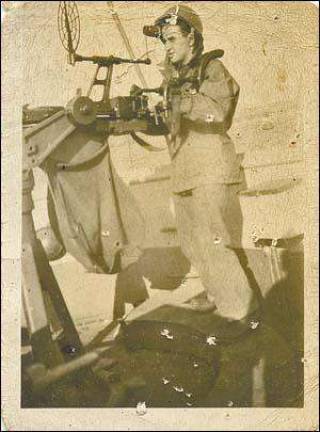WW II veteran recalls his part in D-Day

Stockholm man says he’s pleased that people are showing an interest in history, By Mark J. Yablonsky STOCKHOLM Leonard Peter Riccardi has always been a fighter. He proved it on the battlefield in World War II and later in his life, as he dealt with cancer. And this year, as the nation remembers the 65th anniversary of D-Day on Saturday, June 6, it is fitting that Riccardi tell his story. He was one of many Americans serving the United States Armed Forces in the Second World War. On a raw, overcast day off the coast of northern France, Riccardi was part of a decisive battle that paved the way for victory over Nazi Germany 11 months later. “Ninety percent of the service people who were involved in this operation didn’t even know they were going into it. But it turned out to be the turning point of the war,” explained the quiet-mannered Riccardi, 83. He was finally presented with a Distinguished Service Medal from the state of New Jersey on May 21, 2003. And just last month, the borough of Franklin honored him, too. By spring of 1944, Allied forces, after having driven the Germans out of North Africa the year before, had advanced about halfway up through Italy. But to win the war, it was decided that a third front was needed to close the walls in on the enemy. More than two years in the making, “Operation Overlord,” as Normandy became known, involved some 4,000 Allied ships, 176,000 men and 20,000 armored vehicles that took part in the storming of the Normandy beaches at dawn on the morning of June 6, 1944, making it what is still regarded as the largest invasion force ever assembled. A minesweeper Riccardi was one of the many naval gunners who swept the coast for the numerous mines. Nazi commanders expected the main attack to come about 100 miles further up the coast near Calais, where the English Channel was at its narrowest point but they’d mined the waters anyway. Riccardi was stationed aboard the AM-60 USS Nuthatch, tasked with sweeping for and destroying moored mines, which were anchored some 15 to 20 feet under water. In all, 12 minesweeping ships took part in the invasion, but only six would return by day’s end, the Nuthatch among them. “We were about six or 7,000 yards out, but we were close enough to feel the explosions of the German artillery and our guns going off, too,” Riccardi remembered. “We were right in the middle of it. One of our other ships got hit by a mine. And all I could see was the bow almost bent in half. “With everything that was going on, you could hardly see the water from the ships, and the artilleries. But all you thought about was getting those mines up above the water so we could sink them.” The USS Nuthatch did sustain a major hit nine days later. It underwent repairs and was soon back in action; the mine sweeping activities were to continue along other coastlands for better than a year, at least in the European Theater. Later, Riccardi was asked by the ship’s doctor if he wanted to be a pharmacist, since he had cared for the wounded. He was eventually transferred off the ship to attend pharmacy school. The Nuthatch is no longer in existence. But for Riccardi, his memories are intact. He recently spoke at a local school. “It’s good to see there is a little interest in what we went through,” Riccardi said. Leonard Riccardi, the son of Italian immigrants, grew up in Newark and joined the Navy in January 1944 at the age of 18. He served on the USS Nuthatch during D-Day operations, helping to sweep the waters off Normandy for mines.